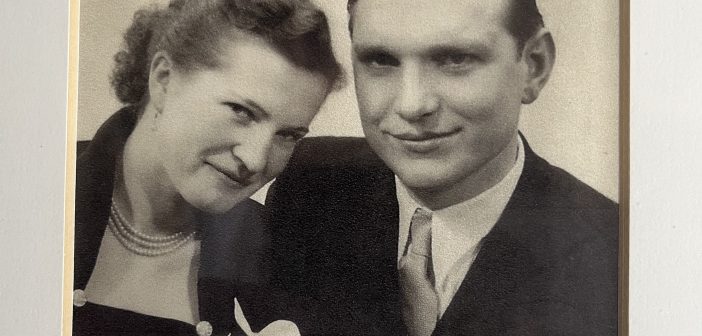Far away but still in view, I stare at the ocean. Thoughts begin to fade away, when suddenly a door opens behind me. My grandfather, Walter, walks in with a cane and a big smile. He is now ninety-three and rarely leaves his house. His thick German accent blares through his office as he greets me. He sits beside me on his ancient leather couch and requests a glass of white wine from his caretaker. I’ve heard the stories that he has told me throughout my entire life, but I never pondered on them too heavily. He would always add something new to the same old story, a detail he left out the last hundred times. It was his way of keeping the tale of his life fresh. Only as I got older did I understand that his narrative is something to be shared, not just listened to.

Outside Walter’s office
Walter Krieg was born in the tiny German village of Pansfelde about a decade before World War II began. His mother was a seamstress and his father is what we would today consider a lumberjack. He had two sisters, one of whom died at age six from a falling tree branch. Every day, Walter would ride his bicycle ten miles to get to a small school located in the middle of the forest. “I used to ride my bike, for maybe an hour or so, before I reached school. It was always freezing during those foggy mornings.” He was eleven when the war started, yet Pansefelde was secluded and they did not receive much news. When he was fourteen, Walter met Ilse, the woman who would become his wife for the rest of his life. They fell in love instantly and were inseparable, spending their entire teenage years with one another. She became his rock and his biggest inspiration throughout the war and life afterwards.
When the war raged across Europe, Hitler Youth was something that was pushed upon all children. Every child at a certain age in Germany was expected to enter. Walter did not receive the same amount of training as kids who lived in larger cities, such as Berlin or Munich, yet he still went to the classes and on small camping trips, learning how to throw grenades and help the injured. Walter saw much less propaganda due to how secluded his village was. “Many people in the village risked execution or jail time by denouncing Hitler in private. A large portion of villagers in Pansfelde did not have the required portraits of Hitler or swastikas placed around their house, and they only put these up when soldiers came into the village, which was rare. I can proudly say my family never liked Hitler, and despised him in secret.” When Walter turned sixteen in 1945, SS soldiers came to his village and recruited all of the able-bodied young men to quickly train and be sent into battle.
“Soldiers came and knocked on all the doors in the village, asking for all boys to meet in the main plaza since all of the men were already fighting in the war. We stood in a single-file line as they inspected us and asked our age. A few children who were too young were sent back to their houses, and the rest of us were loaded into military trucks. Many of the other kids seemed excited, but I was terrified. I could only think of how I would not be able to return to see Ilse. We were taken to the town of Regensburg, in Southern Germany. Within a few days we were training, shooting guns, and learning commands. Around a week before I deployed, I was in a bunker when we were hit by a bomb. The wall exploded from the outside and debris flew everywhere, and some fell on my legs. I went to the medical center for a few weeks and returned to Pansfelde.” My grandfather stares at his cane sitting against the dark brown leather chair. He falls silent for a minute, slowly blinking until he shut his eyes and reminisces about his life so many years ago.
Walter returned to the village of Pansfelde a few days before American soldiers arrived. They arrived on April 17, about two weeks before Hitler committed suicide and Berlin was liberated. Walter explained that the soldiers traded chocolate bars for eggs with the villagers. “Everyone in the village was happy to see American soldiers, once they knew they were not hostile. Some villagers were scared because there was a black soldier, and they had only ever seen white people!” I glared at him. “Opa, we don’t say stuff like that anymore, it’s not appropriate.” He looked back at me with confusion. “I have no intentions of offending anyone, I just want you to realize how secluded Pansfelde was to the rest of Germany and the world.”
After the war was over, Walter stayed in Pansfelde until he was nineteen years old. There were not many well-paying jobs in Pansfelde, so Walter moved to East Germany for two years while Ilse moved to Berlin, learning how to become a seamstress. Walter had some relatives who lived in Berlin, but they lived on the East side, which was Russian-occupied, and citizens there were treated cruelly. He was allowed inside but could not travel to the West side of Berlin, where Ilse’s family lived. He would sneak across the border every month to bring Ilse money and to simply see her. “I remember sneaking around the wall that separated East and West before the actual Berlin wall was built, doing everything possible to visit Ilse. Once the group I was with began to be shot at!”
In 1951 Walter moved to West Germany, near Dortmund. Two years later, Walter and Ilse married on February 21, 1953. Ilse continued to work as a seamstress in Berlin while Walter worked in a coal mine. About a year after they married, Walter and Ilse settled down in West Germany and got an apartment. By 1955, Walter knew that he could find a better life with Ilse somewhere else and began to do research. He found that it was difficult for a German immigrant to enter America, especially after the stigma placed on them after the war. Walter set his sights on Canada and he soon found himself taking a Trans-Atlantic boat alone in 1956. Ilse stayed in Germany to keep their apartment just in case life in Canada did not work out. Walter found a job at a factory and within six months had Ilse move in with him. Having escaped post-war Germany, Walter and Ilse were ready to begin their new lives outside of their war-torn country.
By the autumn of 1957, Walter had a secure job as a steelworker where he worked long hours. He had learned some English from his co-workers and was building a house with Ilse. Walter stayed in contact with his and Ilse’s relatives who still lived in Germany, and constantly bought them gifts that they could not purchase easily there. “Oh, well basically everything you might want. Clothing, plates, silverware, records and lots of Coca-Cola. All things they struggled to get while under Russian occupation. We visited every other year or so.” Walter and Ilse felt guilty leaving their families in a country where it was a challenge to acquire even the most basic of goods. Time seemed to be kind to him and his life stayed like that for a few years. By 1955 he finished his house and continued to work in the steel mill, while Ilse worked as a seamstress, a job she perfected through many years.
A few years later, some German friends contacted them and informed Walter and Ilse that life was nicer down in California, where the weather was more enjoyable, the “American Dream” was thriving and it was possible to get a loan and start a business. In 1961 Walter took a leave of absence and he and Ilse traveled to Los Angeles to meet with their old friends. Instantly Walter and Ilse fell in love with California and decided to move. They returned to Canada and had a child named Christine before gathering their entire life and moving to Los Angeles the next year. Walter found a job at Raytheon and worked there for about a year, remembering, “I truly had no idea what I was doing there. I was surprised I got the job with my thick accent and little knowledge, but it helped me realize that I could work outside of a factory.” During the time they lived in Los Angeles, President John F. Kennedy was assassinated, which made Ilse want to move back to Canada. They lived in a small, cramped apartment and Ilse found Los Angeles too busy. Hoping to find a place where they could both be their happiest, Walter set his sights on a new destination.
Within the same year, another couple that Walter and Ilse grew up with found out that they had moved to California and invited them to stay in Santa Barbara. Walter and Ilse took the trip and instantly fell in love, deciding to live in Santa Barbara for the rest of their lives. Walter finally made an attempt at conquering his dream and took out a loan to purchase two duplexes. “Within two years, I had built four other cottages on the same property that the duplexes were on and rented them out to tenants. I realized that I was making more money renting out property than I was working in any factory. I figured I would much rather own and rent properties than work in coal or steel.” Walter decided to spend the rest of his working life building apartments and homes around Santa Barbara. Within the next ten years, he built a large apartment complex and purchased more property to build cottages on. Ilse and Walter worked together to build and create a new life for themselves and by 1973, they had purchased a few acres up in the Santa Barbara foothills and built their own house with a remarkable view of the ocean. Nearly fifty years later in 2022, Walter and Ilse still live together in the house he built.
As I look up to meet his eyes after typing the last part of the story, I notice Walter’s eyes fixated on the carpet in front of his feet. His hands are clasped together and his mouth is ajar, his mind wandering through over ninety years of life. I continue staring at him patiently as he slowly closes his mouth and his breathing eases. I can sense the emotion wanting to escape. But Water just sits there, his memories soaring by. His eyes are glossy, as if he is going to tear up. Instead he sniffles, blinks heavily and lets out a deep sigh. He smiles and looks over at me.
“Well that’s my story. I’ve told it hundreds of times but it gets harder to tell each time. The details come and go for me.” Walter slowly reaches out his arm and grabs his small, almost-empty glass of wine. “My memory is going, I’m truly getting old!” he blurts out with a large grin. He slowly looks back down at the floor, then at a photo of me when I was in fourth grade. Right as he starts to tell me how happy he is to have me as a grandchild, his caretaker bursts through the door. “Walter, it’s time to take your meds!” He glances at me, rolls his eyes and laughs, the sound of his laughter as familiar and warming as it has always been for me.
His stories bored me as a child, but now they intrigue me as an adult. Perhaps I matured and grew to respect and understand what he went through living in a war-torn country as a child and teenager. I know I will hear the same story next week when I visit him, yet he never tells it the same way.

Walter, 2022




